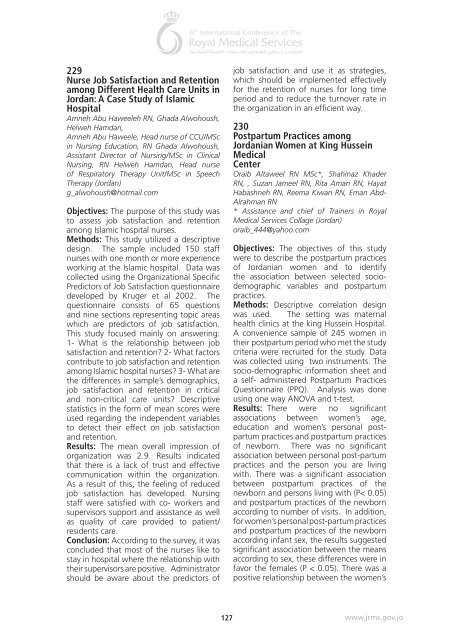Abstract book 6th RMS 16.indd
Abstract book 6th RMS 16.indd
Abstract book 6th RMS 16.indd
Create successful ePaper yourself
Turn your PDF publications into a flip-book with our unique Google optimized e-Paper software.
229<br />
Nurse Job Satisfaction and Retention<br />
among Different Health Care Units in<br />
Jordan: A Case Study of Islamic<br />
Hospital<br />
Amneh Abu Haweeleh RN, Ghada Alwohoush,<br />
Helweh Hamdan,<br />
Amneh Abu Haweele, Head nurse of CCU/MSc<br />
in Nursing Education, RN Ghada Alwohoush,<br />
Assistant Director of Nursing/MSc in Clinical<br />
Nursing, RN Helweh Hamdan, Head nurse<br />
of Respiratory Therapy Unit/MSc in Speech<br />
Therapy (Jordan)<br />
g_alwohoush@hotmail.com<br />
Objectives: The purpose of this study was<br />
to assess job satisfaction and retention<br />
among Islamic hospital nurses.<br />
Methods: This study utilized a descriptive<br />
design. The sample included 150 staff<br />
nurses with one month or more experience<br />
working at the Islamic hospital. Data was<br />
collected using the Organizational Specific<br />
Predictors of Job Satisfaction questionnaire<br />
developed by Kruger et al 2002. The<br />
questionnaire consists of 65 questions<br />
and nine sections representing topic areas<br />
which are predictors of job satisfaction.<br />
This study focused mainly on answering:<br />
1- What is the relationship between job<br />
satisfaction and retention? 2- What factors<br />
contribute to job satisfaction and retention<br />
among Islamic hospital nurses? 3- What are<br />
the differences in sample’s demographics,<br />
job satisfaction and retention in critical<br />
and non-critical care units? Descriptive<br />
statistics in the form of mean scores were<br />
used regarding the independent variables<br />
to detect their effect on job satisfaction<br />
and retention.<br />
Results: The mean overall impression of<br />
organization was 2.9. Results indicated<br />
that there is a lack of trust and effective<br />
communication within the organization.<br />
As a result of this, the feeling of reduced<br />
job satisfaction has developed. Nursing<br />
staff were satisfied with co- workers and<br />
supervisors support and assistance as well<br />
as quality of care provided to patient/<br />
residents care.<br />
Conclusion: According to the survey, it was<br />
concluded that most of the nurses like to<br />
stay in hospital where the relationship with<br />
their supervisors are positive. Administrator<br />
should be aware about the predictors of<br />
job satisfaction and use it as strategies,<br />
which should be implemented effectively<br />
for the retention of nurses for long time<br />
period and to reduce the turnover rate in<br />
the organization in an efficient way.<br />
230<br />
Postpartum Practices among<br />
Jordanian Women at King Hussein<br />
Medical<br />
Center<br />
Oraib Altaweel RN MSc*, Shahinaz Khader<br />
RN, , Suzan Jameel RN, Rita Amari RN, Hayat<br />
Habashneh RN, Reema Kiwan RN, Eman Abd-<br />
Alrahman RN<br />
* Assistance and chief of Trainers in Royal<br />
Medical Services Collage (Jordan)<br />
oraib_444@yahoo.com<br />
Objectives: The objectives of this study<br />
were to describe the postpartum practices<br />
of Jordanian women and to identify<br />
the association between selected sociodemographic<br />
variables and postpartum<br />
practices.<br />
Methods: Descriptive correlation design<br />
was used. The setting was maternal<br />
health clinics at the king Hussein Hospital.<br />
A convenience sample of 245 women in<br />
their postpartum period who met the study<br />
criteria were recruited for the study. Data<br />
was collected using two instruments. The<br />
socio-demographic information sheet and<br />
a self- administered Postpartum Practices<br />
Questionnaire (PPQ). Analysis was done<br />
using one way ANOVA and t-test.<br />
Results: There were no significant<br />
associations between women’s age,<br />
education and women’s personal postpartum<br />
practices and postpartum practices<br />
of newborn. There was no significant<br />
association between personal post-partum<br />
practices and the person you are living<br />
with. There was a significant association<br />
between postpartum practices of the<br />
newborn and persons living with (P< 0.05)<br />
and postpartum practices of the newborn<br />
according to number of visits. In addition,<br />
for women’s personal post-partum practices<br />
and postpartum practices of the newborn<br />
according infant sex, the results suggested<br />
significant association between the means<br />
according to sex, these differences were in<br />
favor the females (P < 0.05). There was a<br />
positive relationship between the women’s<br />
127 www.jrms.gov.jo

















